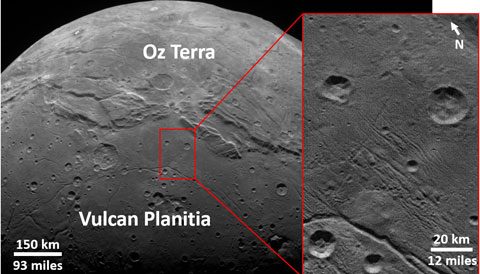
Evidence for a Dark Matter Clump in the Milky Way
There are ghosts in our galaxy’s past. Now astronomers have found a way to detect them.

Astronomers Directly Detect Newborn Planets
Infant planets are coming together in a system 370 light-years away, and they’re shedding light on the early lives of Saturn and Jupiter in our solar system.

Found: Exoplanet in the "Hot Neptune Desert" & Exocomets Around Beta Pictoris
Two teams of astronomers have announced the discovery of a Neptune-size planet in an unexpected orbit and three exocomets whizzing around nearby star Beta Pictoris.

Was ‘Oumuamua a Fragment from a Disintegrated Comet?
A new study suggests that ‘Oumuamua’s strange trajectory back out to interstellar space can be explained if the object had the density of air.

Our Quiet Galaxy Used to Burst with Stars
New research shows that our quiet, middle-aged galaxy used to be quite the firecracker — a couple billion years ago it was exploding with new stars.

Gravitational-wave Detectors Come Online, Find Possible Black Hole-Neutron Star Crash
Only a month into a new observing run, gravitational-wave observatories have announced five new signals — one of which could turn out to be a black hole swallowing a neutron star.

The Aurora Called STEVE Isn’t Aurora After All . . . Mostly
New observations of STEVE, the mauve celestial ribbon that aurora chasers have seen fluttering in the sky, have helped scientists determine the energy source of this unique phenomenon.

Astronomers Find Stars Streaming from Our Galaxy’s Biggest Cluster
Astronomers have discovered a stream of stars pulled from Omega Centauri, the largest and most brilliant globular cluster around the Milky Way — and perhaps a one-time dwarf galaxy.

Astronomers Find Universe’s First Molecule
After decades of searching, astronomers have definitively detected helium hydride, the first molecule to form in the early universe.

Why Are Two Ghost Galaxies Missing Dark Matter?
Ultra-diffuse galaxies are usually dark matter-rich. But astronomers have discovered two of these galaxies that lack dark matter altogether.

Best View Yet of Baby Giant Exoplanet
Astronomers have taken the best spectrum yet of exoplanet HR 8799e, a gas giant in its infancy.

60-Second Astro News: Cannonball Pulsar & Mapping a Star from Afar
In astronomy news this week, scientists found a pulsar racing out of the galaxy and mapped a star's magnetic field from 130 light-years away.

The Milky Way Contains the Mass of 1.5 Trillion Suns
Astronomers are using Gaia and the Hubble Space Telescope to make the most precise measure of the Milky Way’s mass to date. The new result puts our galaxy on par with — if not more massive than — Andromeda.

Tracing the Cigar Galaxy's Superwind
NASA’s SOFIA airborne observatory has returned a striking far-infrared view of the Cigar Galaxy and its “galactic superwind.”

Tilted Exoplanets Could Explain Odd Orbits
Scientists think a significant fraction of exoplanets may be rolling on their sides. If they were, it would explain a longstanding mystery.

Pluto and Charon Are Missing Small Craters
Scientists studying New Horizons images of craters on Pluto and its moon Charon have found that the Kuiper Belt must contain fewer small objects than expected — which suggests the outer solar system hasn’t changed much since its earliest days.

The Beginning of the End for the Hyades Star Cluster
New measurements from the European Space Agency’s Gaia satellite show that the young stars of the Hyades cluster are beginning to drift apart.

Listen Up: Get Gravitational-wave Alerts
The Laser Interferometer Gravitational-wave Observatory (LIGO) will soon begin a new round of observations. Now you can find out about the discoveries as they happen.

Hubble Sets Its Sights on the Ice Giants
New Hubble Space Telescope images reveal an expanded polar cap on Uranus and another mysterious dark vortex on Neptune.

The Milky Way Is Warped in More Ways Than One
Astronomers mapping out luminous stars across our galaxy's disk found that the Milky Way is warped — and multiple factors are twisting its shape.
